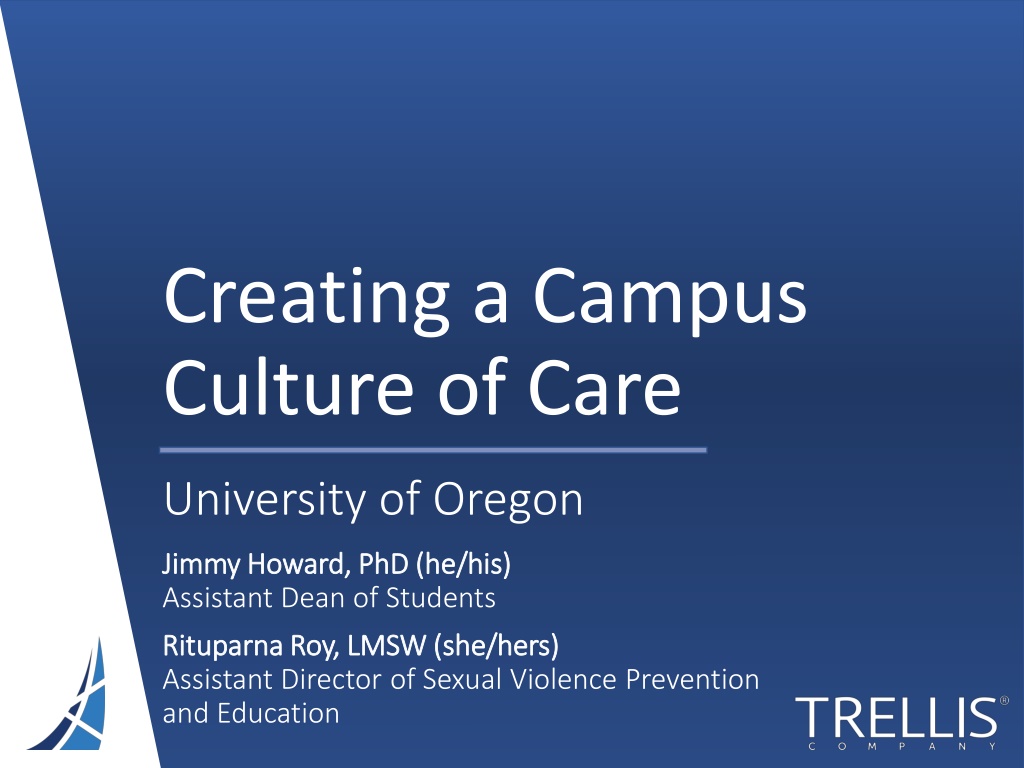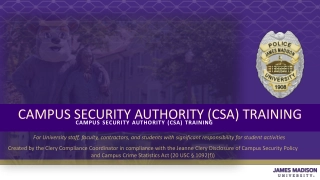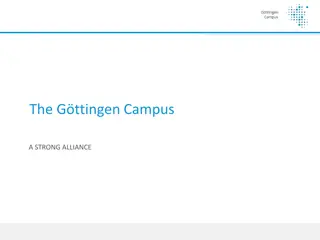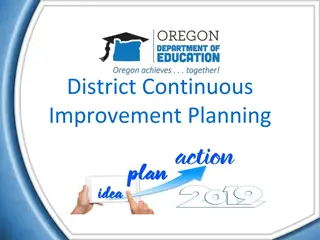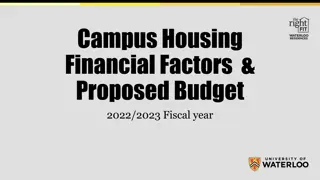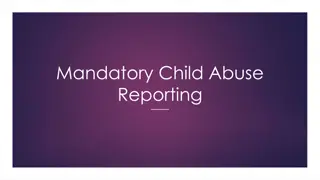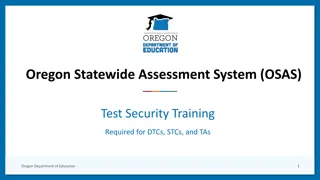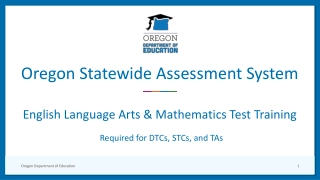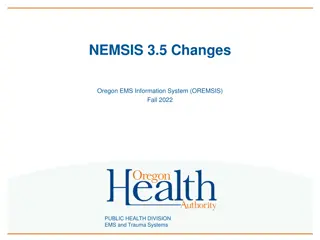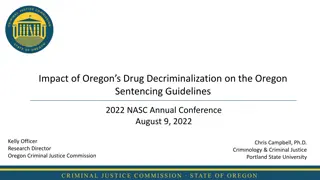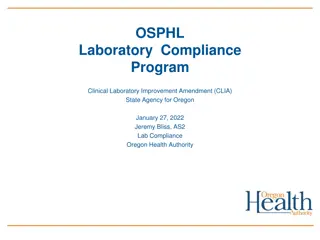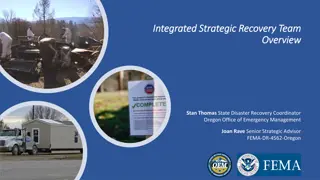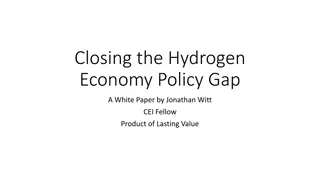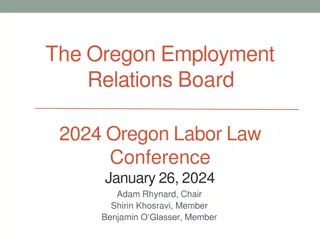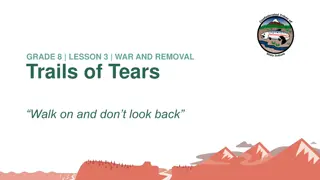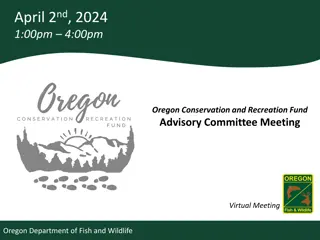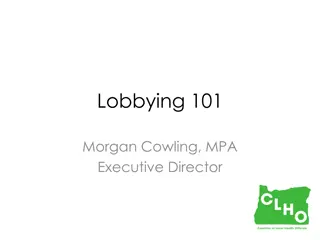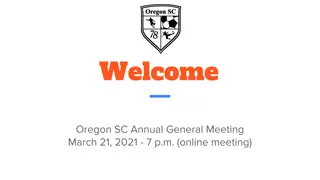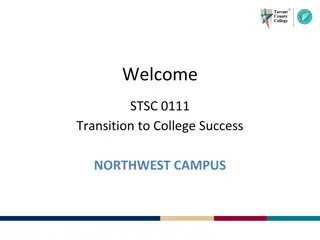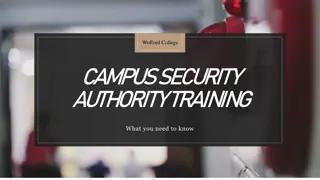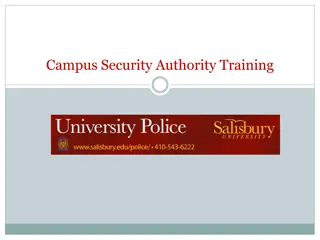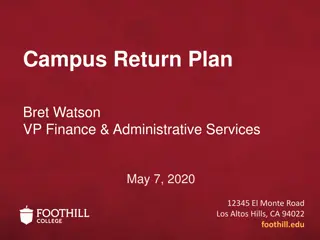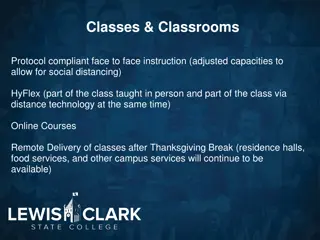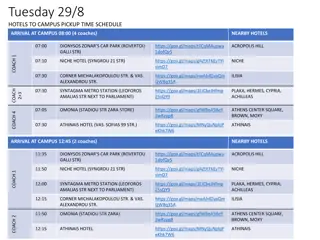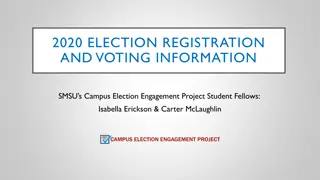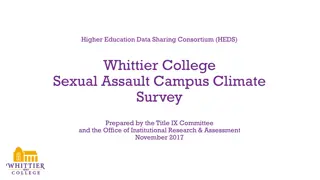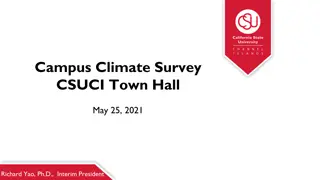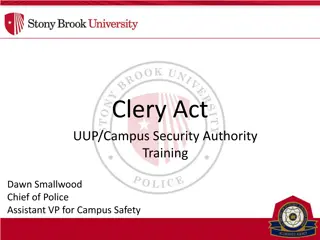Building a Campus Culture of Care at University of Oregon
Explore values contributing to a caring campus culture, trends in student mental health, stressors for marginalized populations, crisis intervention best practices, and roles in student support. Focus on boundary setting and self-care for practitioners with marginalized identities.
Download Presentation

Please find below an Image/Link to download the presentation.
The content on the website is provided AS IS for your information and personal use only. It may not be sold, licensed, or shared on other websites without obtaining consent from the author. Download presentation by click this link. If you encounter any issues during the download, it is possible that the publisher has removed the file from their server.
E N D
Presentation Transcript
Creating a Campus Culture of Care University of Oregon Jimmy Howard, PhD (he/his) Jimmy Howard, PhD (he/his) Assistant Dean of Students Rituparna RituparnaRoy, LMSW (she/hers) Roy, LMSW (she/hers) Assistant Director of Sexual Violence Prevention and Education
Webinar Outcomes Define and clarify those values which contribute to a campus culture of care. Review burgeoning trends on student mental health. Explore elevated stressors occurring for marginalized student populations. Discuss best practices in crisis intervention using a trauma-informed and intersectional lens. Reflect on your role in providing student support. Explore what boundary setting and self-care can mean for practitioners with marginalized identities.
Defining Our Roles STUDENT ADVOCATES CRISIS INTERVENTION Anti-Racist Cultural Humility Anti-Oppressive Safety-Focused Trauma-Informed Student Choice Empowerment-Focused Collaborative Continued Professional Development Universally-Accessible Competent Reflexive Private & Confidential Respect, Dignity and Compassion
Values & Ethical Frameworks
University of Oregon Prevention and Response Center care and student autonomy in our efforts to reduce harm from general crisis, trauma, gender-based violence, substance abuse, and other forms of violence. We educate the community through intersectional feminist praxis and to help students navigate our institutional systems and to encourage resilience.
Trauma Trauma is an emotional response to a terrible event; immediately after the event, shock and denial are typical. Longer term reactions include unpredictable emotions, flashbacks, strained relationships and even physical symptoms like headaches or nausea. While these feelings are normal, some people have difficulty moving on with their lives. (American Psychological Association)
Oppression as a Form of Trauma Impact of Oppression on Care addresses the whole person and the practitioner relates to the (student) in the (student's) social context. Therefore it considers institutional, cultural, & economic issues influence individuals' behaviors and their opportunities to grow into their full potential as persons living within these oppressive contexts. how personal, (Jude M. Hines, 2012)
Oppression as a Form of Trauma Race-Based Traumatic Stress "Racial trauma refers to People of Color and Indigenous individuals' reactions to dangerous events and real or perceived experiences of racial discrimination, including threats of harm and injury, humiliating and shaming events, and witnessing racial discrimination toward other individuals. Although similar to posttraumatic stress disorder, racial trauma is unique in that it involves ongoing individual and collective injuries due to exposure and re-exposure to race-based stress." (Comas-D az, Nagayama Hall, & Neville, 2019)
Healing Centered Approach "holistically involves culture, spirituality, civic action and collective healing. A healing centered approach views trauma not simply as an individual isolated experience, but rather highlights the ways in which trauma and healing are experienced collectively." (Shawn Ginwright, 2018)
The Impact of COVID-19 on Marginalized Students
Healthy Minds Network The Impact of COVID-19 on College Student Wellbeing Two-thirds report their financial situation has become more stressful. Roughly one-third report that their living situation changed as a result of the pandemic. 40% report witnessing race-based discrimination either in person or online. 60% indicate that the pandemic has made it more difficult to access mental health care. (American College Health Association, 2020)
Black, Indigenous, Students of Color Undergraduate Wellbeing During a Pandemic Asian students felt a little less certain about their intellectual and social fit at the university, more anxious about confirming negative stereotypes about their identity group(s), and less satisfied with life during the pandemic than they felt a year prior. Black students felt more self-assured.* Multiracial/Multiethnic students felt a little less healthy and more anxious about confirming negative stereotypes about their identity group(s). No notable differences between pandemic and normal circumstances among Latinx (or White) students. (University of Oregon, 2020)
Lesbian, Gay, Bisexual, Trans, Queer, Questioning, Intersex, Asexual/Aromantic+ Students COVID-19 Related Stress Among LGBTQIA+ University Students 44% hid their LGBTQ+ identity more often. 30% heard family make negative comments about LGBTQ+ people more often. 36% were cautious about their actions around heterosexual/straight people more often. 32% of transgender/nonbinary students reported disrespect of their gender identities more often. 37% experienced an increase in white LGBTQ+ people saying things that were racist. 43% were spending more time educating white LGBTQ+ people about race. (University of Maryland, 2020)
Students with Disabilities The COVID-19 Transitions Student Experiences 56% had difficulty receiving previously approved accommodations. 79% had difficulty possessing needed equipment and devices. 72% had difficulty accessing needed technology support and/or training. 58% had difficulty accessing and receiving academic support and tutoring. 61% had difficulty accessing counseling and mental health services. 75% had difficulty communicating with their course instructors. (Association on Higher Education and Disability (AHEAD), 2020)
Impact of Socio-Economic Status Undergraduate Wellbeing During a Pandemic First-Generation undergraduates felt a little less satisfied with life during the pandemic than they felt a year prior. Undergraduates with lower socioeconomic backgrounds felt a little less satisfied with life. Undergraduates with upper socioeconomic backgrounds felt a little lonelier, sadder, and less like they had peers with whom they could interact socially. (University of Oregon, 2020)
What Is a Crisis? "A crisis is an emotional and physical response to some precipitating event or series of events that disrupts our normal day-to-day functioning." (Hybels-Steer, 1995)
Impact of a Crisis? Depends on: The individual s perception of the event as the cause of considerable upset and/or disruption. The individual s inability to resolve the disruption through coping mechanisms. (Roberts & Yeager, 2007)
Types of Crisis? Single-Episode Exposure Natural disasters, auto accidents, surgeries, crimes, and loss of loved ones. Cumulative/Multiple Exposure Traumatic life experiences that are cumulative in nature. Deliberate Cumulative/Multiple Exposure Prolonged stressors deliberately inflicted by other people. (Roberts & Yeager, 2007)
Stress is a part of every student's life.
WHAT IS YOUR ROLE? NOTICE ENGAGE REFER
NOTICE Notice signs of distress and communicate these to the student and/or supervisor.
Stress: Causes for Concern Uncharacteristic changes in academic performance Uncharacteristic changes in attendance at class or meetings Depressed or lethargic mood Hyperactivity and/or rapid speech Social withdrawal
Stress: Causes for Concern Marked change in personal dress, hygiene, eating and/or sleeping routines Repeatedly falling asleep in class Requests for special consideration, especially if the student is uncomfortable talking about the circumstances prompting the request New or recurrent behavior that pushes the limits of decorum and that interferes with the effective management of your class, work team, etc. Unusual or exaggerated emotional response to events
ENGAGE Have a direct conversation with the student to gather more information, actively listen & express your care and concern if you are comfortable doing so.
HAVE A DIRECT CONVERSATION SET & RESPECT BOUNDARIES SELF-CARE START WITH THE STUDENT
Goals of the Conversation Consider cultural context Center student's reality Assess for safety Care without judgement Collaborate with student around priorities Share information and referrals Allow students to define success Empower students toward self-advocacy
Privacy It is important to maintain privacy with respect to your interaction with the student. Avoid making sweeping promises of confidentiality. In circumstances where people are at risk of harming themselves or another person, it is necessary to breach privacy to ensure the safety of the person.
REFER Be knowledgeable of your institutional policies and resources to appropriately and empathetically refer the student to the support they deserve.
CONSIDERATIONS FOR ACTION What is the impact? What is the level of concern? Situational Awareness & Need to Know Balance of Laws & Institutional Policy
National Behavioral Intervention Team Association (NaBITA) Risk Rubric
Interventions Care Outreach Referral to University and/or Community Resources Administrative Care Meeting Supportive Academic Measures Emergency Contact Notification Welfare Check Emergency Funding Withdrawals Mandatory Leave
Boundaries & Balance In The Workplace
Understanding Your Responses Vicarious Trauma, Compassion Fatigue, Burnout Vicarious Trauma - the profound shift in world view that occurs when helping those who have experienced trauma. One's fundamental beliefs about the world are altered and possibly damaged by being repeatedly exposed to traumatic material. (Pearlman, & Saakvitne, 1995) Compassion Fatigue - the profound emotional and physical erosion that takes place from being unable to refuel and regenerate when supporting others. It has been described as the cost of caring for others in emotional pain. (Figley, 1982) Burnout - the emotional, physical, and mental exhaustion caused by excessive and prolonged stress. Burnout is a gradual process and leads to an overwhelming feeling of "not enough," powerlessness, fatigue and a sense of being worn out. (Smith, Segal, & Robinson, 2019)
Understanding Your Responses Maintaining your ABCs Take time to self reflect. Journal, seek out therapy, talk with loved ones, check in with trusted colleagues or a mentor to help build self-awareness. Awareness Maintain work-life boundaries by developing non-trauma related interests and hobbies. Relaxing meditation, quiet activities, or exercise can be emotionally restorative. Taking take time for yourself is not selfish, it s necessary. Balance Having supportive people in our lives can help reduce isolation and give opportunities to share feelings or experiences. It is also an important way to develop and nurture trusting relationships, which directly help address vicarious trauma and compassion fatigue. Connection
The Personal Is Political Is Professional The unique experiences of marginalization Visibility On/Off Campus - Feeling On and experiencing hyper vigilance. - External assumptions influence action. - Tasked with extra work without compensation. Invisible Identities - Reactions not validated in the workplace. - Constantly assessing safety of disclosure. - Tension of self-advocacy and guilt of being quiet. Personal Impact - Being professional in reactions and responses. - Mistrust around others intentions and actions. - Difficulty empathizing with other experiences. - Compromising which may be viewed as hypocrisy or institutional betrayal. - Balancing amiable working relationships without compromising non-negotiable values. Politics In The Workplace
The Personal Is Political Is Professional Critical Moments of Reflection Which students are accessing you and why? Who is the work you re doing serving? How is the impact of your work positive? Do you have the capacity to continue?
Support at the Workplace Organizational (Supervisor Support) Individual Societal Community Instititutional
Contact For follow-up questions or a full list of resources and toolkits, please contact: Jimmy Howard jhoward8@uoregon.edu Ritu Roy ritu@uoregon.edu
Proven Services. Extraordinary Support.
